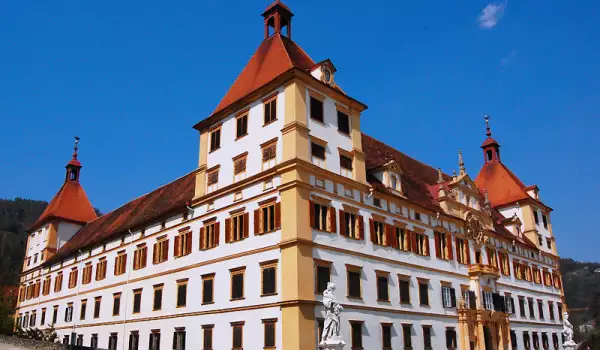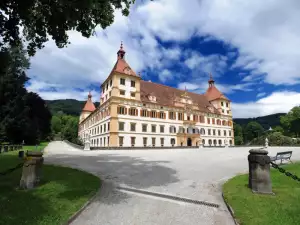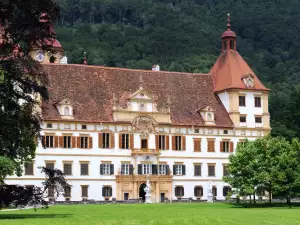Eggenberg Palace

Eggenberg Palace was built outside the popular with beauty Old Town of Graz, but is one of the largest and binding to visit attractions in this Austrian city. Eggenberg has incredibly beautiful Baroque architecture and is connected to the cultural heritage of the Old Town Graz, in 2010 together Schlossberg, where you can see the ruins of the strongest fortress in the world (according to the book with Guinness World Records).
Eggenberg is located about 3 km west of the historic center of Graz, and was built in the early 17th century, in 1600, the year the German architecture turns more toward the gothic decorations and medieval forms as a whole. In 1623, in Austria, was built palace Eggenberg that includes many of these Gothic ideals. Today Eggenberg Palace is considered the most important and significant baroque palace in the southeastern Austrian province of Styria, and among the most valuable cultural monuments throughout the country.
In the center of the complex stands a beautiful baroque palace, surrounded by landscaped gardens and a park. Basis for Eggenberg are made on the orders of the royal governor Hans Ulrich von Eggenberg (1538-1634), who was chief minister of Emperor Ferdinand II. The palace was intended to serve as his residence and its magnificent architecture had to show dominance and strength of family Eggenberg.

The basis of the architectural ensemble of the palace Eggenberg underlie complex mathematical and allegorical schemes of beautiful details in the decoration depicting an architectural universe and space, and are a corrective to the ruler Eggenberg . Architecture and design of the palace are all influenced by visions of cosmic harmony. Original designer of Eggenberg is the most blatant at that time master - Giovanni Pietro de Pomis.
He had an unlimited resource of money and completed the palace in just 10 years. After his death, the task to complete a magnificent residence falls to Pietro Valnegro and Antonio Pozzo. Finalization of Eggenberg was at the end of 17 century, where every detail is neat - from design, furniture, tapestries and decorations to the main rooms and magnificent Planetary Room in 1685.
In the mid-18th century most of the rooms in Eggenberg Palace are restored rococo by order Princess Maria Elenora. From that time until today, it has been preserved in its authentic form - 3 rooms in eastern styles, including the palace church, which was incorporated to Eggenberg as a small theater. Over the next 100 years at the palace absolutely nothing happens it was purchased by the family Herberstein. They completely changed the interior of the living quarters downstairs, according to their taste, but the official halls are not changed.

Today Eggenberg Palace is open for public visits at the entry fee of several euros, for the garden only, a ticket is 1 euro. The palace is open from 30 April to 31 October, Tuesday to Sunday between 10:00 and 17:00. There is a tremendous amount to consider - starting with four corner towers, representing the four Morellaons and ending in symbolizing time (weeks, days, hours and minutes) detail.
Eggenberg has a total of 365 windows, 56 of them are located in 24 rooms, symbolizing weeks and a year. On the second level are the state rooms - 24 in number, arranged in an oval shape and represent a 24-hour day. On each floor, Eggenberg Palace has just 31 rooms, which correspond to the days in the month. More like a lot of allegories in Eggenberg.
Planetary hall of the palace was named for the eponymous cycle of paintings, the work of Hans Adam Weissenkircher. You can see the unique paintings of oil on canvas, depicting the signs, planets in the galaxy and the four earthly powers. Over 24 rooms can be seen about 600 magnificent paintings on the ceilings, which translate the Greek mythology, Roman scenes, religious scenes from the Old Testament and the historical legends of Western Europe.
The park and inside the Eggenberg houses exhibitions of the museum Universalmuseum Joanneum. In that framework, you can see archeological exposition and interesting collection of coins of Archduke Johann, who gave them of Styria in the early 20 century. In the park of Eggenberg particularly impressive is the so- called Planetary Garden (The Planetary Garden), located in the northern corner of the complex.















